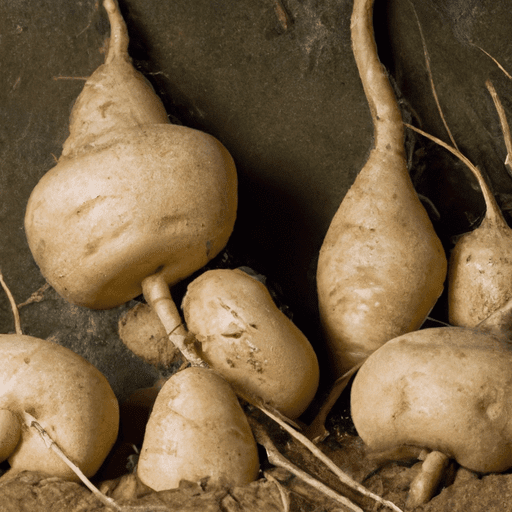Exploring the Versatile Yam Bean: A Delightfully Nutritious Ingredient for Your Kitchen
If you are on the lookout for a versatile and nutritious ingredient to elevate your cooking, look no further than the yam bean. Also known as jicama or Mexican turnip, this humble tuber deserves a special place in your kitchen. With its crisp texture, mild flavor, and impressive nutritional profile, the yam bean is a true culinary gem. Let’s dive deeper into this extraordinary ingredient and discover its culinary possibilities!
Taste and Texture of Yam Bean:
The yam bean’s flavor profile can be described as subtly sweet, similar to a crisp and refreshing apple. Its mild taste makes it a versatile ingredient that can be integrated into various dishes. The texture is exceptionally crisp, delivering a satisfying crunch with every bite. This unique texture has earned the yam bean a reputation as an excellent alternative to water chestnuts in many recipes.
Common Uses in Cooking:
The yam bean’s versatility shines through in its culinary applications. Raw or cooked, it offers a delightful addition to both sweet and savory dishes. Here are some common ways to incorporate the yam bean into your cooking:
1. Salads and Slaws:
When raw, the yam bean shines as the star of salads and slaws. Slice it into matchstick-sized pieces or use a mandoline for uniform cuts. Its refreshing crunch adds a refreshing element to any salad, making it an ideal choice for summer gatherings or as a crisp counterbalance to contrasting flavors.
2. Stir-fries and Sautes:
In cooked dishes, yam bean brings a unique texture and mild flavor. Add thin slices or julienned yam bean to stir-fries or sautes for an unexpected twist. The yam bean retains its crispness even when cooked, providing a pleasant contrast to tender meats and vegetables.
3. Snacks:
Looking for a nutritious alternative to processed snacks? Look no further! Raw yam bean can be peeled and sliced into rounds, creating a healthy and refreshing snack. Pair it with your favorite dip or enjoy it on its own for guilt-free munching.
4. Beverages:
While not as common, some cuisines utilize yam bean in beverages. The tuber’s natural sweetness and refreshing qualities make it a great addition to smoothies or freshly squeezed juices, adding a unique twist to your favorite drinks.
Nutritional Value:
In addition to its culinary appeal, the yam bean packs a nutritional punch. Here are some key nutrients found in this versatile ingredient:
- Dietary Fiber: Yam bean is an excellent source of dietary fiber, promoting healthy digestion and aiding in weight management.
- Vitamins and Minerals: It is rich in vitamin C, which boosts immunity and acts as an antioxidant. Yam beans also contain potassium, magnesium, and iron, all essential for maintaining overall health.
- Low in Calories: With its low-calorie content, yam bean is an ideal addition to a balanced and weight-conscious diet.
Interesting History and Facts:
While the yam bean may be a relatively unknown ingredient to some, it holds a special place in various culinary traditions. Here are some intriguing history and facts about this remarkable tuber:
- Origin: The yam bean originates from Central and South America, where it has been cultivated for centuries. It remains a popular ingredient in Mexican, Filipino, and Southeast Asian cuisines.
- Native Name: The term “jicama” derives from the Nahuatl language spoken by the Aztecs, who named it “xicamatl.” The name “xicamatl” roughly translates to “edible root.”
- Cultural Significance: In Mexico, jicama is often sprinkled with chili powder, lime juice, and salt, creating a popular street snack known as “jicama con chile.”
- Alternative Names: The yam bean goes by various names around the world, such as “singkamas” in the Philippines and “bang kuang” in Thailand.
- Medicinal Uses: Traditional medicine systems in some cultures utilize the yam bean for its diuretic, anti-inflammatory, and detoxifying properties.
:
The yam bean, with its mild flavor, refreshing crunch, and impressive nutritional profile, is truly a hidden culinary gem. Whether you choose to enjoy it raw, cooked, or in creative recipes, this versatile tuber brings a delightful twist to your dishes. From salads to stir-fries, snacks to beverages, the yam bean offers endless possibilities to elevate your cooking. Let your culinary curiosity guide you as you explore the culinary wonders of this extraordinary ingredient!
Yam Bean
Origin: The yam bean, also known as jicama, Mexican turnip, or Mexican potato, is native to Mexico and Central America. It is believed to have been domesticated in these regions thousands of years ago.
Common Uses: The yam bean is commonly used in various culinary preparations. It is often added raw to salads, slaws, or salsas for its crisp texture and refreshing flavor. It can also be cooked and used in stir-fries, soups, stews, and even baked dishes. In some cuisines, it is used as a substitute for water chestnuts or potatoes.
Nutritional Benefits: Yam beans are low in calories but provide a good amount of dietary fiber. They are also a good source of vitamin C, which is important for immune function and collagen synthesis. Additionally, they contain important minerals such as potassium and magnesium. Yam beans are also known for their antioxidant properties.
Unique Properties: The most remarkable characteristic of the yam bean is its crunchy and juicy texture. Its flavor is mildly sweet and nutty, with hints of pear and watermelon rind. It has a thin brown skin that needs to be peeled before consumption. The flesh is usually white, but some varieties can have yellowish or brownish tones.
Historical Significance: Yam beans have a long history in Mexican and Central American cuisines. They were an important part of the pre-Columbian diet and their cultivation predates the arrival of the Spanish conquistadors. Yam beans were highly valued by indigenous civilizations due to their taste, versatility, and nutritional value, and they continue to be widely consumed in these regions to this day.




Use the share button below if you liked it.
It makes me smile, when I see it.